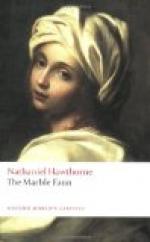There were two persons, however, whom she appeared to acknowledge as friends in the closer and truer sense of the word; and both of these more favored individuals did credit to Miriam’s selection. One was a young American sculptor, of high promise and rapidly increasing celebrity; the other, a girl of the same country, a painter like Miriam herself, but in a widely different sphere of art. Her heart flowed out towards these two; she requited herself by their society and friendship (and especially by Hilda’s) for all the loneliness with which, as regarded the rest of the world, she chose to be surrounded. Her two friends were conscious of the strong, yearning grasp which Miriam laid upon them, and gave her their affection in full measure; Hilda, indeed, responding with the fervency of a girl’s first friendship, and Kenyon with a manly regard, in which there was nothing akin to what is distinctively called love.
A sort of intimacy subsequently grew up between these three friends and a fourth individual; it was a young Italian, who, casually visiting Rome, had been attracted by the beauty which Miriam possessed in a remarkable degree. He had sought her, followed her, and insisted, with simple perseverance, upon being admitted at least to her acquaintance; a boon which had been granted, when a more artful character, seeking it by a more subtle mode of pursuit, would probably have failed to obtain it. This young man, though anything but intellectually brilliant, had many agreeable characteristics which won him the kindly and half-contemptuous regard of Miriam and her two friends. It was he whom they called Donatello, and whose wonderful resemblance to the Faun of Praxiteles forms the keynote of our narrative.
Such was the position in which we find Miriam some few months after her establishment at Rome. It must be added, however, that the world did not permit her to hide her antecedents without making her the subject of a good deal of conjecture; as was natural enough, considering the abundance of her personal charms, and the degree of notice that she attracted as an artist. There were many stories about Miriam’s origin and previous life, some of which had a very probable air, while others were evidently wild and romantic fables. We cite a few, leaving the reader to designate them either under the probable or the romantic head.
It was said, for example, that Miriam was the daughter and heiress of a great Jewish banker (an idea perhaps suggested by a certain rich Oriental character in her face), and had fled from her paternal home to escape a union with a cousin, the heir of another of that golden brotherhood; the object being to retain their vast accumulation of wealth within the family. Another story hinted that she was a German princess, whom, for reasons of state, it was proposed to give in marriage either to a decrepit sovereign, or a prince still in his cradle. According to a third statement, she was the off-spring of a Southern American planter, who had given her an elaborate education and endowed her with his wealth; but the one burning drop of African blood in her veins so affected her with a sense of ignominy, that she relinquished all and fled her country. By still another account she was the lady of an English nobleman; and, out of mere love and honor of art, had thrown aside the splendor of her rank, and come to seek a subsistence by her pencil in a Roman studio.




